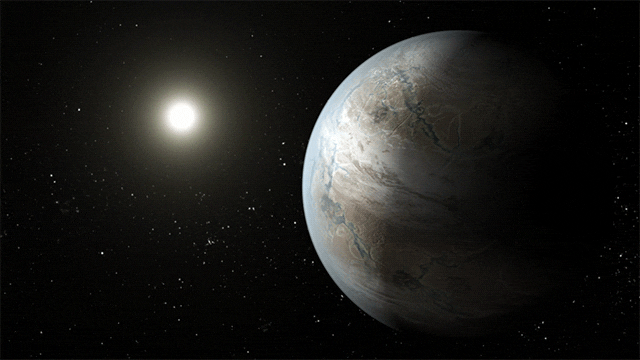AI Reveals Unsuspected Connections Hidden in the Complex Math Underlying Search for

Artist’s concept of a sun-like star (left) and a rocky planet about 60% larger than Earth in orbit in the star’s habitable zone. Gravitational microlensing has the ability to detect such planetary systems and determine the masses and orbital distances, even though the planet itself is too dim to be seen. Credit: NASA Ames/JPL-Caltech/T. Pyle
Machine learning algorithm points to problems in mathematical theory for interpreting microlenses.
Artificial intelligence (AI) systems trained on real astronomical observations now surpass astronomers in filtering through massive amounts of data to find new exploding stars, identify new types of galaxies, and detect the mergers of massive stars, boosting the rate of new discovery in the world’s oldest science.
But a type of AI called machine learning can reveal something deeper, exoplanets when such planetary systems pass in front of a background star and briefly brighten it — a process known as gravitational microlensing — revealed that the decades-old theories now used to explain these observations are woefully incomplete.
In 1936, Albert Einstein himself used his new theory of general relativity to show how the light from a distant star can be bent by the gravity of a foreground star, not only brightening it as seen from Earth, but often splitting it into several points of light or distorting it into a ring, now called an Einstein ring. This is similar to the way a hand lens can focus and intensify light from the sun.
But when the foreground object is a star with a planet, the brightening over time — the light curve — is more complicated. What’s more, there are often multiple planetary orbits that can explain a given light curve equally well — so called degeneracies. That’s where humans simplified the math and missed the bigger picture.

Seen from Earth (left), a planetary system moving in front of a background star (source, right) distorts the light from that star, making it brighten as much as 10 or 100 times. Because both the star and exoplanet in the system bend the light from the background star, the masses and orbital parameters of the system can be ambiguous. An AI algorithm developed by UC Berkeley astronomers got around that problem, but it also pointed out errors in how astronomers have been interpreting the mathematics of gravitational microlensing. Credit: Diagram courtesy of Research Gate
The AI algorithm, however, pointed to a mathematical way to unify the two major kinds of degeneracy in interpreting what telescopes detect during microlensing, showing that the two “theories” are really special cases of a broader theory that, the researchers admit, is likely still incomplete.
“A machine learning inference algorithm we previously developed led us to discover something new and fundamental about the equations that govern the general relativistic effect of light- bending by two massive bodies,” Joshua Bloom wrote in a blog post last year when he uploaded the paper to a preprint server, arXiv. Bloom is a UC Berkeley professor of astronomy and chair of the department.
He compared the discovery by UC Berkeley graduate student Keming Zhang to connections that Google’s AI team, DeepMind, recently made between two different areas of mathematics. Taken together, these examples show that AI systems can reveal fundamental associations that humans miss.
“I argue that they constitute one of the first, if not the first time that AI has been used to directly yield new theoretical insight in math and astronomy,” Bloom said. “Just as Steve Jobs suggested computers could be the bicycles of the mind, we’ve been seeking an AI framework to serve as an intellectual rocket ship for scientists.”
“This is kind of a milestone in AI and machine learning,” emphasized co-author Scott Gaudi, a professor of astronomy at The Ohio State University and one of the pioneers of using gravitational microlensing to discover exoplanets. “Keming’s machine learning algorithm uncovered this degeneracy that had been missed by experts in the field toiling with data for decades. This is suggestive of how research is going to go in the future when it is aided by machine learning, which is really exciting.”
Discovering exoplanets with microlensing
More than 5,000 exoplanets, or extrasolar planets, have been discovered around stars in the Most have been detected because they create a Doppler wobble in the motions of their host stars or because they slightly dim the light from the host star when they cross in front of it — transits that were the focus of

This infographic explains the light curve astronomers detect when viewing a microlensing event, and the signature of an exoplanet: an additional uptick in brightness when the exoplanet lenses the background star. Credit: NASA, ESA, and K. Sahu (STScI)
One of the main goals of NASA’s Nancy Grace Roman Space Telescope, scheduled to launch by 2027, is to discover thousands more exoplanets via microlensing. The technique has an advantage over the Doppler and transit techniques in that it can detect lower-mass planets, including those the size of Earth, that are far from their stars, at a distance equivalent to that of
But if the foreground star has a planet, the planet creates a separate brightness peak within the peak caused by the star. When trying to reconstruct the orbital configuration of the AI Reveals Unsuspected Connections Hidden in the Complex Math Underlying Search for


